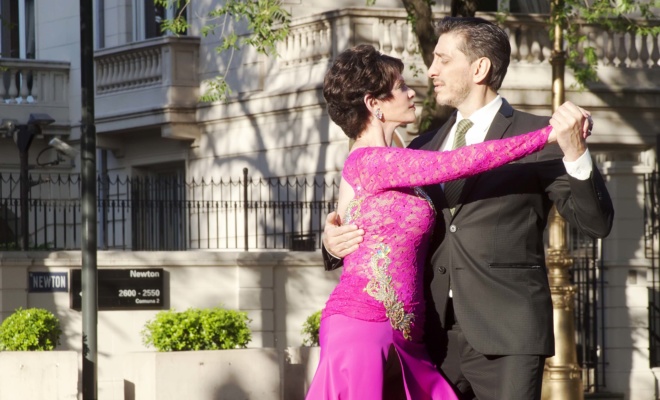
Feature
First Tango In Buenos Aires
Wendy Feinstein pursues her passion for the Argentine Tango
by Ryan G. Van Cleave
The first thing Sarasota resident Wendy Feinstein said when asked about the tango is that people need to realize there’s a big difference between the Argentine tango — which she adores — and the American tango. Comparing them is “like comparing apples and oranges,” she says. The differences are indeed many. To name just a few, the Argentine tango is primarily improvisational, and its dancers move in a close embrace where the lead comes from the leader’s chest to the follower’s chest, while their lower bodies are pushed away so they have room to move. The American tango is far more formal, and the dancers utilize a lot of upper body movements such as sways and dips. The accompanying music, too, greatly differs, with American tango music being steady and rhythmic, almost like a ticking clock, whereas Argentine tango music can vary greatly.
Wendy fell in love with the Argentine tango when she visited South America with her husband, Jerry, nearly five years ago to do some hiking in Patagonia. She’s a big fan of being active outdoors, having already climbed the four tallest mountains in the contiguous 48 states. At the end of that Southern American trip, Jerry told Wendy that he wanted to take her to “the best tango show in all of Buenos Aires.”
The show he took her to was by the performance troupe Rojo Tango, and it simply blew her away. “I cried like a baby,” she says. “It grabbed me. And when the show was over, I told Jerry that in my next life, I want to come back as a tango dancer.” He leaned over to her and said, “Why do you have to wait until your next life?”
They immediately made plans to return to Buenos Aires so she could begin lessons with her first Argentine tango teacher, Mauro Holzmann. Jerry does not dance tango, but he loves that his wife’s found something she’s so passionate about. And now that he’s taken up photography, he’s constantly snapping photos of her dancing. When they go out with friends, Jerry is the one pulling out photos of Wendy dancing and showing them around!
Fortunately, Wendy has found a local dance teacher, Luis Pena, to work with 5 days a week, 2 hours a day. “He’s the man who taught me to dance,” she says about Pena. Yet, she was worried that her summers in Aspen, CO — where she and Jerry live from mid-June to mid-October — wouldn’t allow her to continue her studies. Despite Aspen being a very small town, Heather Morrow, the only dance instructor within a 4-hour radius of Wendy, lives walking distance from Wendy’s house… and as luck would have it, Morrow’s a dancer who learned the Argentine tango in Buenos Aires. Wendy says, “She works with me on what they call ‘feminine techniques,’ such as the positioning of one’s hands, foot articulation, and the way to keep your knees together.” She notes that these things are difficult for a man to teach a woman, but for another woman? It’s easy and natural. And they dance together all summer, working on these techniques.
“What I love about the tango is how challenging it is,” says Wendy. “It’s far more difficult than climbing any mountain. Plus you can’t even be thinking about the steps. You have to be so connected to the music and your partner that the steps just happen. You have to be in the zone and stay in the zone for the entire dance.”
She notes that dancers tango in sets of three or four, called a tanda. So if you’re at a Milonga (a social event or location for tango dancing) and someone invites you to dance, be aware that you’re agreeing to a number of dances — not just one. The first dance? You probably aren’t able to follow them. The second? You’re doing better because you’ve connected a bit more. By the third, you’re dancing well with them. It really takes three dances to figure it out.
As of Valentine’s Day this year, Wendy will have had four straight years of tango lessons with Pena in Sarasota, Morrow in Aspen, and Carlos Copello — the star of the Rojo Tango show that so moved her — in Buenos Aires. What’s truly remarkable is that when Pena took her to Buenos Aires along with two other students he worked with at Sara Dance Center, an independent studio on Fruitville Road, she met Flavio Catuara and Gladys Barreiro, world-class tango dancers. “Flavio saw something in me,” Wendy explains. “From the very first time we danced, he has become one of my most important teachers.” He was so impressed by her, in fact, that he invited her to be his partner at the Tango Buenos Aires Festival and Dance World Cup in August. She has a difficult time expressing just how special this is since few Americans participate in this event, and with a world-class talent like his? He could have his pick of partners. This isn’t a pro-am event, either, where a top talent picks an amateur.
Pena knows Flavio and his way of dancing, so when Wendy practices each day with him, Pena plays the role of Flavio so she can be better prepared for the contest. It’s difficult to practice with a partner who lives 4,500 miles away! Wendy and Jerry have already rented an apartment for an entire month around the contest so Wendy can have a few weeks of practice with Flavio to get themselves ready.
“I’ll be jumping out of my skin if I make it past the first day,” she says. “The real win, though, is just being invited.” She’s taking it seriously to the point that she’s essentially pushed aside all of her other outdoor interests — kick boxing, cycling, skiing, and, in her own words, being a gym rat. “When I discovered how much of a passion I had for it, I kind of gave up everything. And it’d never be possible without Jerry being 100% supportive. He’s a gem!”
One of her favorite expressions about the tango is “you’re never there,” meaning that you never master it. It’s a lifelong pursuit for unattainable perfection. To hear Wendy speak about it, it seems like an incredibly worthwhile, rewarding pursuit nevertheless.




You must be logged in to post a comment Login